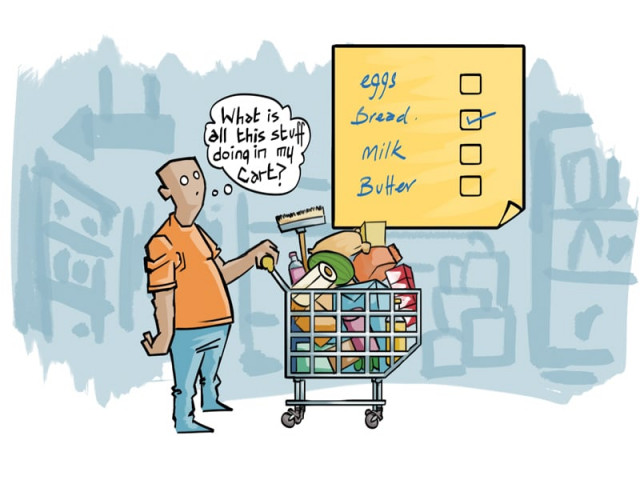Trolley-ology: Games supermarkets play
Trolley psychology reveals the tactics supermarkets use to make customers spend more.

Trolley psychology reveals the tactics supermarkets use to make customers spend more. ILLUSTRATION: JAMAL KHURSHID
If you live in an urban setting, you probably know this feeling all too well: you step into the supermarket, focused solely on quickly getting hold of a few minor items, only to emerge over an hour later maneuvering a cart full of items that exceed half of your monthly budget.
Well, if the late Eric Berne is watching, he’s probably appalled at how long it’s taken researchers in our time to respond with ‘trolleyology’: the study of the various tactics and designs that supermarkets employ to tempt the customer to make unplanned purchases.
Now that it’s finally here though, some very interesting findings have emerged to evidence the long-held rumour that large supermarket chains spend millions of dollars on experiments and studies examining consumer behaviour in stores. A recent contribution by journalist Kate Browne in Australia’s Choice magazine, ‘Supermarket sales tricks’, has sparked worldwide interest in the area, and also given new life to a classic piece in the New York Times by famed journalist Jack Hitt, ‘The Theory of Supermarkets.’
Let’s have a look at some of these games and see which ones have migrated to the local landscape.
The Milk and Bread game
This one may be referred to as the ‘parent of all supermarket games.’ The trick is to put the most frequently bought item, milk, at the farthest point from the entrance. Other essential items, such as bread, are then put in another corner altogether. This way you have to make something akin to a pilgrimage around the store, with most people falling prey to various ‘impulse buys’ in the process.
The Super-Sized Cart game
This is another classic one. Carts are engineered to be larger, significantly larger, than the amount of the food that the average customer would put in there if there was no cart. Now the customer who went in just for a bag of wheat and some kitchen items is subject to the embarrassment of looking cheap in front of the staff with a few items placed in a giant cart. Throw in next month’s supply in there.
The Check-out Line game
Now that you and the children are tired and waiting in a typically understaffed area of check-out lines, you conveniently find a range of temptations — chocolate bars, cold drinks, chewing gum — just within arm’s reach. Your dupatta is being pulled at with increasing zeal, and you must either give in or unleash the might of your child’s lungs.
The Marketplace game
Here, Browne incorporates the work of consumer psychologist Dr Paul Harrison of Deakins University, who has identified the more recent trend of arranging the supermarket to look like a marketplace: items are arranged in different ‘markets’, ideally with visual distinctions and individual counters. The effect is to make you feel like you’ve visited several different stores, which we feel is much smarter than spending so much in just one big shop.
The effect is compounded if you encounter a bakery along the way. According to Harrison, this gives the effect of making the supermarket appear trustworthy: ‘How considerate it is of them to be serving us with freshly baked goods.’
Newer, more sophisticated, games include placing the most expensive products at the eye-level of targeted customers. As Hitt gleans, research by consumer think-tanks in the US show that the average eye-height of men and women is 64 and 59 inches, respectively, and that shelves, are typically viewed from four feet away at a 15 degree downward angle. Consequently, a ‘choice elevation’ of 51 to 53 inches has been identified — and supermarkets charge companies extra to place their products at this ‘prime space.’ Children’s products have their own prime space amongst the lowest shelves.
Not the least, whether child or adult, you’ll be surveying these upscale items, likely after having entered the supermarket from a door on the right side, and moving in an anti-clockwise direction, which Browne explains is the case because research in the US has shown that customers traveling in an anti-clockwise direction will, on average, spend two dollars more on average.
Then again, these supermarkets don’t know that some of us are coming in with our research done.
The author is the head of Scholars by Profession, a local research-initiative. Find out more at www.facebook.com/scholarsbyprofession, or reach Haris at harishseyal@gmail.com
Published in The Express Tribune, April 15th, 2013.
Like Life & Style on Facebook for the latest in fashion, gossip and entertainment.



















COMMENTS
Comments are moderated and generally will be posted if they are on-topic and not abusive.
For more information, please see our Comments FAQ